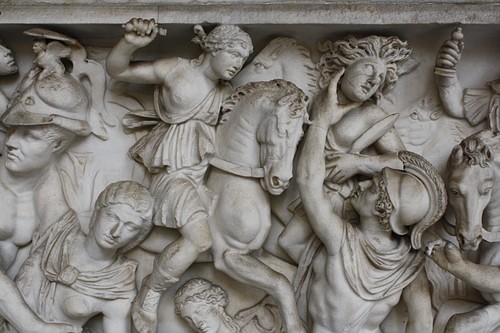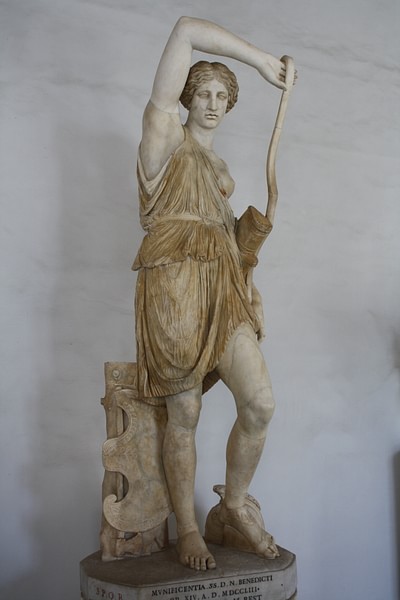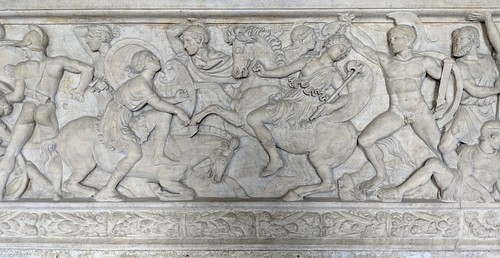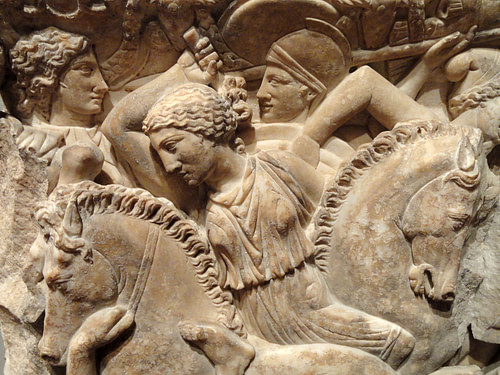A Genre of Art That Depicts the Mythical Amazons
In Greek mythology, the Amazons were a race of warlike women noted for their riding skills, courage, and pride, who lived at the outer limits of the known globe, sometimes specifically mentioned as the city of Themiskyra on the Black Sea. Their queen was Hippolyte, and although Homer tells us they were 'the equal of men', they most famously fought and lost separate battles against iii Greek heroes: Hercules, Theseus, and Bellerophon. Scenes from these battles were popular in Greek art, especially on pottery and in monumental sculpture adorning some of the near important buildings in the Greek earth, including the Parthenon of Athens. Intriguingly, archaeological investigation of tombs across Eurasia has shown conclusively that many women of nomadic steppe tribes were indeed warriors, particularly effectually the Black Sea area.
Origins & Name
In mythology, the Amazons were daughters of Ares, the god of war. They were members of a women-only order where men were welcomed only for convenance purposes and all male infants were killed. They were thought to dwell at the border of what the Greeks considered their 'civilized' world and were nearly often associated with the area around the southern coast of the Black Sea, particularly the city-state of Themiskyra. Another Anatolian connection was at Ephesus, where it was thought Amazons had sacrificed to the goddess of hunting Artemis at her temple there and performed war dances, a ceremony repeated annually thereafter. Indeed, the foundation of many settlements in Asia Small-scale was credited to Amazons, notably Ephesus, Cyme, Sinope, Priene, Myrina, Smyrna, and Mytilene on Lesbos.
Archaeological digging of Sarmatian tombs dating to the time of Herodotus has revealed the likelihood that some of their women were warriors.
Herodotus (c. 484 – 425/413 BCE), writing in his Histories (Bk. 4, 110-117), gives a lengthy clarification of a meeting betwixt Amazons and Scythians. Young warriors of the latter group persuaded a number of visiting Amazons to prepare a new social club together, with the women insisting neither they nor their offspring would change their lifestyles at all. This new race was considered the origins of the Sarmatians in southern Russia, appropriately enough, a people famous for their horses and armed services aggression.
Essentially, the society of the Amazons was thought of every bit Greek male person-social club in opposite and so they pursued such traditional male person-dominated activities as equus caballus-riding, hunting, and warfare. In fable (with no supporting historical bear witness), the Amazons burnt off their correct breast in order to better apply a bow and throw a spear, indeed, the term a-mazon was popularly understood as pregnant 'breastless', although culling meanings include 'one breast' or 'not breast-fed.' Another alternative origin of the proper noun is that it comes from Farsi and ways only 'warrior.' I concluding interpretation is that the name derives from the Armenian, pregnant 'Moon-goddess', and refers to priestesses of the Moon on the southern shores of the Black Body of water who did, on occasion, conduct arms. Interestingly, Amazons are not depicted in ancient Greek fine art with a missing breast. The historian Adrienne Mayor suggests that the literary confusion, therefore, comes from the similarity betwixt mazon and the Greek word for chest mastos. In art, Amazons are most often depicted wearing hoplite armour and they oftentimes ride a horse. The most common weapons are the bow and spear, merely there are also examples where Amazons carry axes. They were not simply regarded every bit capable warriors but too particular experts at ambush and cavalry charges.

Penthesilea & Achilles
Fighting Greek Heroes
Hercules & Hippolyte
The commencement meeting between Greeks and Amazons, according to mythology, was when Hercules was sent by Eurystheus, the king of Mycenae, Tiryns, and Argos, on one of his historic twelve labours (the 9th), this time to fetch the girdle of the Amazon queen Hippolyte. The girdle was given by her begetter Ares, and the task was gear up by Eurystheus precisely because it was an impossibly dangerous endeavour. In some versions of the story, Hercules goes lone, but in other accounts, he first assembles an army led by the finest Greek warriors, including the hero Theseus. In some versions, the taking of the girdle turned out to be rather easier than expected when Hippolyte willingly handed it over, but in other versions, Hera - always against Hercules because he was the fruit of her husband's illicit affair with Alkmene - stirred up the Amazons to give the Greek hero and his army a hot reception. Fine fighters though the Amazons were, they were no match for the invincible Hercules who took the girdle dorsum to Eurystheus.
Intriguingly, our earliest depictions of the story in pottery predate the literary sources for the tale by two centuries, and they sometimes show Hercules fighting an Amazon named Andromache or Andromeda, and in none is a belt e'er depicted. This is, once again, testify that the oral myths were more complicated and varied than the literary versions that have survived. A more definite plot element is that during this expedition Theseus fell in love with and abducted (or eloped with) the Amazon Antiope, an action which would atomic number 82 to a second run into between Greeks and Amazons.

Wounded Amazon
Hercules fighting Amazons was represented in sculpture on the frieze of the Treasury of the Athenians at Delphi (490 BCE), on the Temple of Apollo at Bassae, on the Hephaisteion of Athens (449 BCE) and on metopes on the Temple of Zeus at Olympia (470-456 BCE). The throne of the statue of Zeus at Olympia, one of the 7 Wonders of the ancient earth, was likewise decorated with scenes from this famous myth.
Theseus & Antiope
The oldest depiction of a warrior fighting an Amazon is on a terracotta votive shield from 700 BCE.
Theseus eventually became the ruler of Athens, but the Amazons had not forgotten the loss of ane of their members and and then launched an trek to rescue Antiope. Theseus defeated the barbarian invaders but during the battle, Antiope was killed. Theseus abducting Antiope is the bailiwick of the pediment from the Temple of Apollo at Eretria (c. 510 BCE) and on the metopes of the Treasury of the Athenians at Delphi. Athens was also the location of annual sacrifices to the Amazons.
Bellerophon & Amazons
Bellerophon was involved in a third meeting between Greeks and Amazons. He was another hero who had to perform impossible tasks in service to a king. This time Proitos, king of Argos, outraged at (false) accusations from his wife that Bellerophon had attacked her, sent the hero to serve Iobates, male monarch of Lycia. Information technology was he who set the hero the chore of killing the Chimera - a fantastic creature which was a fire-animate mix of panthera leo, serpent, and caprine animal - and when Bellerophon managed that feat, he was told to go off and fight the Amazons. Naturally, the Greek hero won the day and was even made heir to Iobates' kingdom on his victorious return.

Greeks Battling Amazons
Achilles & Penthesilea
A fourth and final coming together with Amazons came towards the end of the Trojan War. In the Epic Cycle, we are told that the Amazon Penthesilea, daughter of Ares and the Amazon Otrere, aided the Trojans but was killed in battle by Achilles. In some accounts, Achilles fell in beloved with his victim when he removed her helmet simply equally she expired. The scene is captured on a celebrated blackness-figure vase past Exekias (c. 540 BCE).
Amazonomachies
More general Amazonomachies (battles with Amazons) were present on the shield of the cult statue of Athena Parthenos inside the Parthenon (438 BCE), on the west pediment of the Temple of Asclepius at Epidaurus (395-375 BCE), on the Temple of Athena Nike on the Athenian Acropolis (c. 425-420 BCE), on the Tholos of Delphi (380-370 BCE), and on the Temple of Ares in the agora of Athens. The oldest delineation of a warrior fighting an Amazon is on a terracotta votive shield from 700 BCE. Hercules fighting Amazons is the hero's second most popular labour depicted on Greek black-figure pottery (after the Nemean lion) with almost 400 surviving examples. Amazons fighting unnamed warriors were common throughout the 6th and 5th centuries BCE both on black- and ruby-red-effigy Greek pottery.
In particular, during the 5th century BCE in Athens, these mythological battles with Amazons came to represent contemporary events, i.eastward. the battles between Greeks and the invading Persians during the Persian Wars. The armies of Darius I at Marathon (490 BCE), Xerxes at Salamis, and the Western farsi assault on Athens itself in 480 BCE came to be represented past Amazons every bit the ultimate in roughshod foreigners; indeed depictions of Amazons on pottery in this period are shown really dressed in Farsi costume. Public buildings and their accompanying sculpture were, without doubt, an important method of mass communication, and depictions of heroes fighting Amazons reminded ordinary people that the political leaders had successfully defended Greek civilisation confronting the threat of strange, and in Greek eyes less civilized, invaders.

Amazonomachy Detail
Amazons in Archaeology
Archaeological excavation of Sarmatian tombs and those of other nomadic tribes elsewhere, peculiarly in Kazakhstan and dating to the fourth dimension of Herodotus, has revealed the likelihood that some of these women were warriors. Female person skeleton remains were non only constitute with weapons, armour, and horse trappings but also signs of injury from blades and arrowheads. One item Scythian grave, dating to the 4th century BCE and located near aboriginal Tyras on the Dniester River on the northern coast of the Black Sea, contained a female skeleton with a wound in the skull probably caused by a boxing-axe and a bronze arrowhead firmly stuck in one genu. The deceased had been surrounded by two iron spears, 20 arrows with bronze arrowheads and a bronze knife, as wells as pieces of body armour.
Far from being unique, skeletal analysis and study of their accompanying objects reveal that of over 1,000 such steppe nomad graves, spread across territories from Turkey to Russia, an impressive 37% were warrior women, many of whom had survived and/or succumbed to injuries typical of one-on-ane violent combat. Most graves date to the 5th-4th century BCE and the women are, similar the Amazons of Greek mythology, always young - betwixt the historic period of 16 and 30 years onetime. It certainly seems and so, that once again, Greek myth-makers, historians and artists were inspired not only by their imaginations when they created and depicted the Amazon legends but by the historical reality of Eurasian fighting women.
This article has been reviewed for accuracy, reliability and adherence to academic standards prior to publication.
Source: https://www.worldhistory.org/amazon/
0 Response to "A Genre of Art That Depicts the Mythical Amazons"
Post a Comment